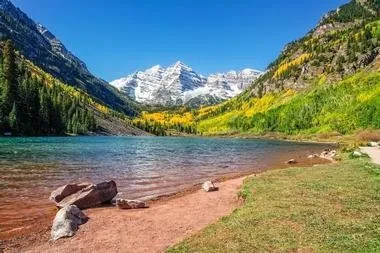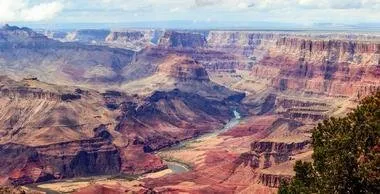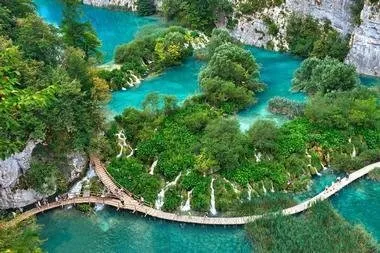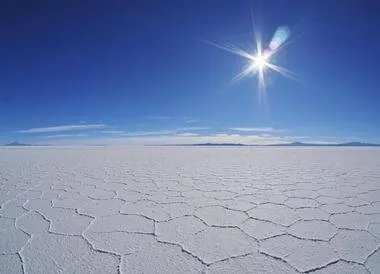No two people will agree upon which of the beautiful places in the world, natural or manmade, should make the list of the best 5. How can you choose between so many spectacular mountain ranges, sparkling emerald lakes, thundering waterfalls, dreamy ancient towns perched on high cliffs, and parks that attract millions of people from all over the world? Inevitably, any such list is immensely personal and can only touch minds and inspire visits to all corners of the world, where nature’s majesty is richly woven with human endeavor.
Maroon Bells, USA

Located only about 10 miles from Aspen, Colorado, the Maroon Bells are two 14,000-foot peaks in the Elk Mountains that are reflected in crystal-clear Maroon Lake, snuggled in a glacial valley. They are the crown jewels of the Rocky Mountains and by far one of the most photographed scenes in the country.
It is difficult to say when the timeless beauty of these two sentinels mirrored in the lake is more striking: In the summer, when every hiking trail takes you through fields of wild flowers, in the fall, when tall aspen trees dazzle with a rainbow of fall colors, or in the winter, when snow and ice silence the world. The best photo opportunities are from one of the many hiking trails – access by motor vehicles is limited. The lake is popular among fly-fishermen – even if they don’t catch anything, the beauty all around them is enough.
»Grand Canyon, USA

The Grand Canyon is a steep, 1-mile-deep, and up to 18-mile-wide gash in the fabric of the world, an immense gorge carved by the Colorado River over the last 5,000 years. Its sheer size is breathtaking and although you can see only a small portion of it even from the best vantage point, its geology and its age fire the imagination. The layers of colorful rock show the passage of time and some of the rocks at the bottom are 1,8 billion years old.
There is a lot of life growing on the canyon’s steep sides – you can see more of it hiking the trails of the northern rim, where it is also less crowded. Most people limit their visit to the breathtaking views from the southern rim. Some of the most popular viewpoints are Yavapai Observation Station, Mary Colter’s Lookout Studio, and Mather Point.
Oia, Santorini, Greece

Located on top of a cliff with a spectacular view of the Palea volcano, Nea Kameni, and the island of Thirassia, Oia is the most popular and arguably the most beautiful of all the picturesque villages of the beautiful Greek island of Santorini. Only about 11 km from Fira, on the north of the island, Oia will charm you with its traditional stone houses lining the narrow streets, breathtaking blue-domed churches, and sunbaked verandas.
While the village has its share of taverns, souvenir shops, and cafes, Oia is more quiet and laid-back than busy Fira and most people enjoy its quaint beauty by slowly exploring its narrow streets. Stroll through the village’s small port of Ammoudi by descending 300 steps down the cliff, or enjoy colorful galleries showcasing art from the many artists who fell in love with the village and made it their home. Photo: Photocreo Bednarek/Fotolia
Plitvice Lakes, Croatia

Located about halfway between the Croatian capital Zagreb and Zadar on the coast of the Adriatic Sea, Plitvice Lakes are a magical world of living, moving water surrounded by ancient forests, 16 lakes linked by waterfalls, bridges natural and man-made, and 300 square kilometers of wild beauty full of bears, wolves, boars, and birds.
The difference in altitude between 1,280 meters at the highest point and 280 meters at the lowest creates a seemingly endless number of falls, big and small, that permanently fill the air with spray and fog. Wooden and natural walkways and hiking trails spin around and across the lake and a ferry on Lake Kozjak shuttles people between the upper and lower lakes. The lakes are beautiful all year round, but especially when mirroring magical fall colors or the lacy frozen branches of the surrounding trees. Next read: Croatia Attractions Photo: twin designer/Fotolia
Salar de Uyuni, Bolivia

Salar de Uyuni, located high up in the Andes in southwest Bolivia at an altitude of 11,995 feet, is the largest salt flat in the world, covering over 4,086 square miles. It was once a prehistoric lake that dried up, leaving behind 11,000 square kilometers of otherworldly desert-like landscape made up of sparkling bright white salt, bizarre rock formations, and strange cacti-covered islands. The best spot to observe this surreal landscape is central Incahuasi Island.
There is not much wildlife in this fairly barren ecosystem, except for about 80 species of birds and the thousands of pink flamingos that come in November. The salt crust, between 7 and 66 feet deep, covers a sea of brine. The salt is very rich in lithium, accounting for up to 70 percent of the world’s reserves of the mineral.